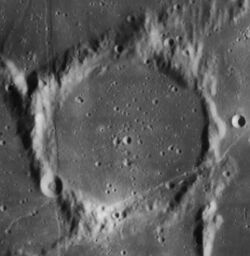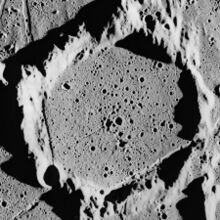Astronomy:Parry (crater)
 Lunar Orbiter 4 image | |
| Diameter | 48 km |
|---|---|
| Depth | 0.6 km |
| Colongitude | 16° at sunrise |
Parry is a lunar impact crater that is attached to the southeast rim of the walled plain Fra Mauro. It was named after British explorer William Parry.[1] Attached to the west and southwest rim of Parry is the crater Bonpland. Due south of Parry is the small crater Tolansky, and farther to the south-southwest is Guericke.
The rim of Parry is heavily worn and slightly distorted due to the co-joined formations. The wall is the most prominent along the northwest, and crossed along the southwest by the small Parry B. The floor has been flooded by lava, and is relatively flat. At the midpoint is a pair of small craters.
A rille system, called the Rimae Parry, crosses the region in a series of graben. One rille crosses the southeast rim of Parry in a northeast direction before crossing the east rim and continuing a short distance across the surrounding mare. Another extends from Tolansky crater across the west side of Parry and into Fra Mauro crater. One other crosses the north rim of Bonpland crater and into Fra Mauro where it intersects with another rille.
Satellite craters

By convention these features are identified on lunar maps by placing the letter on the side of the crater midpoint that is closest to Parry.
| Parry | Latitude | Longitude | Diameter |
|---|---|---|---|
| B | 8.9° S | 13.0° W | 1 km |
| C | 6.8° S | 12.7° W | 3 km |
| D | 7.9° S | 15.7° W | 3 km |
| E | 8.3° S | 16.3° W | 6 km |
| F | 7.6° S | 14.7° W | 4 km |
| L | 6.3° S | 14.7° W | 7 km |
| M | 8.9° S | 14.5° W | 26 km |
The following craters have been renamed by the IAU.
- Parry A — See Tolansky (crater).
References
- ↑ "Parry (crater)". Gazetteer of Planetary Nomenclature. USGS Astrogeology Research Program.
- ↑ Apollo 16 Preliminary Science Report, NASA Special Publication 315, 1972. Chapter 29, part B: Cayley Formation interpreted as basin ejecta.
- Andersson, L. E.; Whitaker, E. A. (1982). NASA Catalogue of Lunar Nomenclature. NASA RP-1097.
- Bussey, B.; Spudis, P. (2004). The Clementine Atlas of the Moon. New York: Cambridge University Press. ISBN 978-0-521-81528-4.
- Cocks, Elijah E.; Cocks, Josiah C. (1995). Who's Who on the Moon: A Biographical Dictionary of Lunar Nomenclature. Tudor Publishers. ISBN 978-0-936389-27-1. https://archive.org/details/isbn_9780936389271.
- McDowell, Jonathan (July 15, 2007). "Lunar Nomenclature". Jonathan's Space Report. http://host.planet4589.org/astro/lunar/.
- Menzel, D. H.; Minnaert, M.; Levin, B.; Dollfus, A.; Bell, B. (1971). "Report on Lunar Nomenclature by the Working Group of Commission 17 of the IAU". Space Science Reviews 12 (2): 136–186. doi:10.1007/BF00171763. Bibcode: 1971SSRv...12..136M.
- Moore, Patrick (2001). On the Moon. Sterling Publishing Co.. ISBN 978-0-304-35469-6. https://archive.org/details/patrickmooreonmo00patr.
- Price, Fred W. (1988). The Moon Observer's Handbook. Cambridge University Press. ISBN 978-0-521-33500-3.
- Rükl, Antonín (1990). Atlas of the Moon. Kalmbach Books. ISBN 978-0-913135-17-4.
- Webb, Rev. T. W. (1962). Celestial Objects for Common Telescopes (6th revised ed.). Dover. ISBN 978-0-486-20917-3. https://archive.org/details/celestialobjects00webb.
- Whitaker, Ewen A. (1999). Mapping and Naming the Moon. Cambridge University Press. ISBN 978-0-521-62248-6.
- Wlasuk, Peter T. (2000). Observing the Moon. Springer. ISBN 978-1-85233-193-1.
External links
 |



